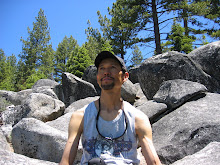Living T'ai Chi Principles in Everyday Life
By Chris Sequeira
The word T'ai Chi also (Taiji) implies the interaction of opposing qualities, referred to as Yin/Yang, such as light and dark, positive and negative, male and female, fast and slow, etc. without which life would not be possible. Many people associate the word T'ai Chi with T'ai Chi Chuan, which is a martial art that strives to apply the appropriate use of opposing forces to achieve harmony while dealing with an opponent. When practiced for health purposes, it is an attempt to balance the forces within the body and in its movements. It is a perfect blend of relaxation and exercise.
However, the T'ai Chi philosophy has even broader applications that can be useful in everyday life apart from martial arts and formal exercise routines. To live T'ai Chi is to be in a continuous awareness of all the elements of your life, both inner and outer, as they present themselves, and to stay balanced and harmonious to the best of your ability.
How we stand and breathe has a considerable impact on our total well-being. I would like to share some simple but profound principles that can be applied in everyday life. These are suggestions and ideas based on my experience with Chinese meditation, healing traditions, and Taoist philosophy. My purpose is not to foster more beliefs and concepts but to invite people to investigate for themselves and come to their own direct experience and knowledge. I am aware that more details and subtleties exist and cannot be fully addressed in an article of this size. The following is a guideline for what is known as the Wu Chi standing meditation posture. The bodily alignments discussed are the basis of T'ai Chi Chuan posture. It represents the starting point from which the exercise routine begins. It is recommended to begin with shorter sessions and to increase the duration over time. If standing is not possible, you can sit comfortably straight with the palms resting above the knees, applying the principles accordingly.
Stand with your feet about shoulder width apart and pointing forward. Center your weight behind the balls of your feet and in front of your heels. With your knees slightly bent allow your hips to settle as you let go of any tension you may be holding in the small of your back. This will aid in letting your pelvis tuck gently forward as if you are sitting on a stool. Do not force the posture but maintain a sense of ease. Let your shoulders and arms hang loosely with your middle fingers touching the sides of your thighs. Gently raise the top of your head, being careful to keep your chin pulled gently inward. Touch the tip of your tongue to your upper palate. Maintain a sense of softness within this shape, avoiding rigidity. Your eyes may be closed or gently opened and slightly angled downward.
Bringing your awareness to your breath, allow your belly to expand naturally as you inhale through your nose. Release any tension in your chest and solar plexus. Witness your body as it seems to breathe itself. As you exhale, sense a wave of release from the top of your head down towards the earth. Feel the mass of your body sinking downward with each breath like sand in an hourglass, giving you the impression that your legs and feet are the heaviest part of your body. Let your mind and emotions quiet down as your weight surrenders to gravity. Allow your breath to gradually become slower and longer. Allow any disturbing qualities, whether they are emotional, mental or physical, to drift downward like a muddy pool gradually becoming clear. As your body is becoming more relaxed, sense new energy gathering with each inhalation. In calm attention, you feel the vitality buzzing in every cell of your body. Sense the pure awareness and presence in which all your life experiences are known. Thinking is not a problem as you settle into that which is conscious of thought and therefore unbound by it. Here you recognize the silent knowingness that you have always been. Yet in its depths you may discover a sense of wonder, mystery and peaceful joy. Here is your link to Wu Chi, which can be defined as the unmanifest open field of all possibilities from which T'ai Chi, as the dynamic play of existence, is continually arising. In this core of fundamental human consciousness you are poised in what is called the Heart of Heaven and Earth. When you are in Wu Chi awareness, which is only in the Now, you are at a fresh beginning of your unfolding life story, the true point of power. Herein lie the roots of intelligence, creativity, feeling sensitivity, deep appreciation and trust in life as it is. Here is the potential for effective action and for a movement toward holistic wellness.
The standing, or Wu Chi meditation posture has physically therapeutic and healing functions and can be applied anytime, anywhere, whether waiting in line or watching a sunset. A brief session can be quite effective, but a longer one can provide more depth. But knowing, resting in and living from your fundamental awareness and being, deeper than anything that is subject to change, can occur regardless of posture, activity, or inactivity.
I have been conducting classes in T'ai Chi basics, forms, meditation and Qigong in the Mission, Noe Valley and Diamond Heights neighborhoods since the early 1980's. Feel free to contact me with your questions and if you would like to participate in our meetings at 415-773-8185 or at Livingtaichi@yahoo.com. , www.livingtaichisf.com
Saturday, November 22, 2008
Subscribe to:
Post Comments (Atom)

1 comment:
Greetings chris,
Make videos
Jay
Post a Comment